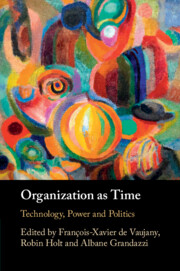Book contents
- Organization as Time
- Organization as Time
- Copyright page
- Contents
- Figures
- Tables
- Contributors
- Organization as Time
- Part I The Politics of Time: Ontologies and Metaphysics of Organization as Time
- Part II Re-orienting Critique in Organization Studies? Exploring Jointly Time and Politics
- 5 Supersessionism and the Politics of Time
- 6 Between Abandon and Inquiry
- 7 Future Work
- 8 Towards a Crinicultural Activism in Organization
- Part III New Ways of Organizing Work, Digitality and the Politics of Time
- Part IV History and Duration: Making Things Last, Enduring Politics and Organizing
- Index
- References
7 - Future Work
Toward a Practice Perspective
from Part II - Re-orienting Critique in Organization Studies? Exploring Jointly Time and Politics
Published online by Cambridge University Press: 22 June 2023
- Organization as Time
- Organization as Time
- Copyright page
- Contents
- Figures
- Tables
- Contributors
- Organization as Time
- Part I The Politics of Time: Ontologies and Metaphysics of Organization as Time
- Part II Re-orienting Critique in Organization Studies? Exploring Jointly Time and Politics
- 5 Supersessionism and the Politics of Time
- 6 Between Abandon and Inquiry
- 7 Future Work
- 8 Towards a Crinicultural Activism in Organization
- Part III New Ways of Organizing Work, Digitality and the Politics of Time
- Part IV History and Duration: Making Things Last, Enduring Politics and Organizing
- Index
- References
Summary
In the ‘future of work’ in particular and organizations more generally, the future is a ubiquitous companion and serves as a key point of orientation for actions. However, at the same time, the future is elusive, as its open-endedness undermines attempts to fully predict and ‘manage’, but also examine this temporal mode. In response to the intricate challenge of exploring the role of the future in organizations, we argue that practice theory can help us gain a deeper understanding of how organizational actors engage with the future. By revisiting key principles of practice theory and their relationships with time and the future, we propose to explore ‘future work’, i.e., the situationally enacted, performative, heterogeneous, and relationally entwined bundle of practices through which organizational actors engage with events that are to come. We conclude by discussing the implications of gaining a practice-based understanding of the future in organizations and suggest avenues for future research.
Keywords
- Type
- Chapter
- Information
- Organization as TimeTechnology, Power and Politics, pp. 136 - 155Publisher: Cambridge University PressPrint publication year: 2023

